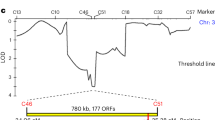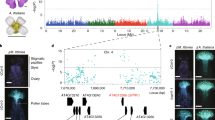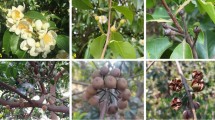Abstract
FLOWERING plants have evolved various stratagems to prevent inbreeding and promote outcrosses1. One such mechanism, gametophytic self-incompatibility, provides a genetic barrier to self-fertilization, and in the simplest cases is controlled by the highly polymorphic S locus2. Growth of a pollen tube in the style is arrested when the S allele carried by the pollen matches one of the two S alleles carried by the pistil. Putative S allele proteins of the pistil have been identified in several solanaceous species based on their co-segregation with S alleles3–12, and they have been shown to be ribonucleases13–15. So far, there has been only correlative or indirect evidence for the claim that these S allele-associated proteins (S proteins) are involved in recognition and rejection of self pollen16,17. Here we show that inhibition of synthesis of S3 and S2 proteins in Petunia inflata plants of S2S3 genotype by the antisense S3 gene resulted in failure of the transgenic plants to reject S3 and S2 pollen. We further show that expression of the transgene encoding S3 protein in P. inflata plants of S1S2 genotype confers on the transgenic plants the ability to reject S3 pollen. The self-incompatibility behaviour of the pollen was not affected by the transgene in either set of experiments. Taken together, these find-ings provide direct in vivo evidence that S proteins control the self-incompatibility behaviour of the pistil.
This is a preview of subscription content, access via your institution
Access options
Subscribe to this journal
Receive 51 print issues and online access
$199.00 per year
only $3.90 per issue
Buy this article
- Purchase on Springer Link
- Instant access to full article PDF
Prices may be subject to local taxes which are calculated during checkout
Similar content being viewed by others
References
Frankel, R. & Galun, E. in Monographs on Theoretical and Applied Genetics (eds Frankel, R., Gall, G. A. E. & Linskens, H. F.) 5–50 (Springer, Berlin, 1977).
de Nettancourt, D. in Monographs on Theoretical and Applied Genetics (eds Frankel, R., Gall, G. A. E. & Linskens, H. F.) 28–57 (Springer, Berlin, 1977).
Bredemeijer, G. M. M. & Blass, J. Theor. appl. Genet. 59, 185–190 (1981).
Anderson, M. A. et al. Nature 321, 38–44 (1986).
Kamboj, R. K. & Jackson, J. F. Theor. appl. Genet. 71, 815–819 (1986).
Mau, S. L. et al. Planta 169, 184–191 (1986).
Broothaerts, W. J. et al. Pl. molec. Biol. 14, 93–102 (1989).
Kirch, H.-H., Uhrig, H., Lottspeich, F., Salamini, F. & Thompson, R. D. Theor. appl. Genet. 78, 581–588 (1989).
Ai, Y. et al. Sex. Pl. Reprod. 3, 130–138 (1990).
Kheyr-Pour, A. et al. Sex. Pl. Reprod. 3, 88–97 (1990).
Xu, B., Grun, P., Kheyr-Pour, A. & Kao, T.-h. Sex. Pl. Reprod. 3, 54–60 (1990).
Ai, Y., Kron, E. & Kao, T.-h. Molec. gen. Genet. 230, 353–358 (1991).
McClure, B. A. et al. Nature 342, 955–957 (1989).
Singh, A., Ai, Y. & Kao, T.-h. Pl. Physiol. 96, 61–68 (1991).
Broothaerts, W., Vanvinckenroye, P., Decock, B., Van Damme, J. & Vendrig, J. C. Sex. Pl. Reprod. 4, 258–266 (1991).
Singh, A. & Kao, T.-h. in Sexual Reproduction in Flowering Plants (eds Russell, S. D. & Dumas, C. ) 449–483 (Academic, San Diego, 1992).
Sims, T. L. Crit. Rev. Pl. Sci. 12, 129–167 (1993).
Coleman, C. E. & Kao, T.-h. Pl. molec. Biol. 18, 725–737 (1992).
Clark, K. R., Okuley, J. J., Collins, P. D. & Sims, T. L. Pl. Cell 2, 815–826 (1990).
Lewis, D. Heredity 3, 339–355 (1949).
Horsch, R. B. et al. Science 227, 1229–1231 (1985).
Linsmaier, E. M. & Skoog, F. Physiol. Pl. 18, 100–127 (1965).
Lee, H.-S., Singh, A. & Kao, T.-h. Pl. molec. Biol. 20, 1131–1141 (1992).
Oeller, P. W., Min-Wong, L., Taylor, L. P., Pike, D. A. & Theologis, A. Science 254, 437–439 (1991).
loerger, T. R., Gohlke, J. R., Xu, B. & Kao, T.-h. Sex. Pl. Reprod. 4, 81–87 (1991).
Author information
Authors and Affiliations
Rights and permissions
About this article
Cite this article
Lee, HS., Huang, S. & Kao, Th. S proteins control rejection of incompatible pollen in Petunia inflata. Nature 367, 560–563 (1994). https://doi.org/10.1038/367560a0
Received:
Accepted:
Issue Date:
DOI: https://doi.org/10.1038/367560a0
This article is cited by
-
Biotechnological approaches to overcome hybridization barriers and use of micropropagation tool for further improvement in Heliconia: a review
Plant Cell, Tissue and Organ Culture (PCTOC) (2022)
-
Breeding of ornamentals: success and technological status
The Nucleus (2022)
-
Downregulated expression of S2-RNase attenuates self-incompatibility in “Guiyou No. 1” pummelo
Horticulture Research (2021)
-
Caspase-like proteases and the phytohormone cytokinin as determinants of S-RNAse–based self-incompatibility–induced PCD in Petunia hybrida L.
Protoplasma (2021)
-
The origin and widespread occurrence of Sli-based self-compatibility in potato
Theoretical and Applied Genetics (2020)
Comments
By submitting a comment you agree to abide by our Terms and Community Guidelines. If you find something abusive or that does not comply with our terms or guidelines please flag it as inappropriate.



